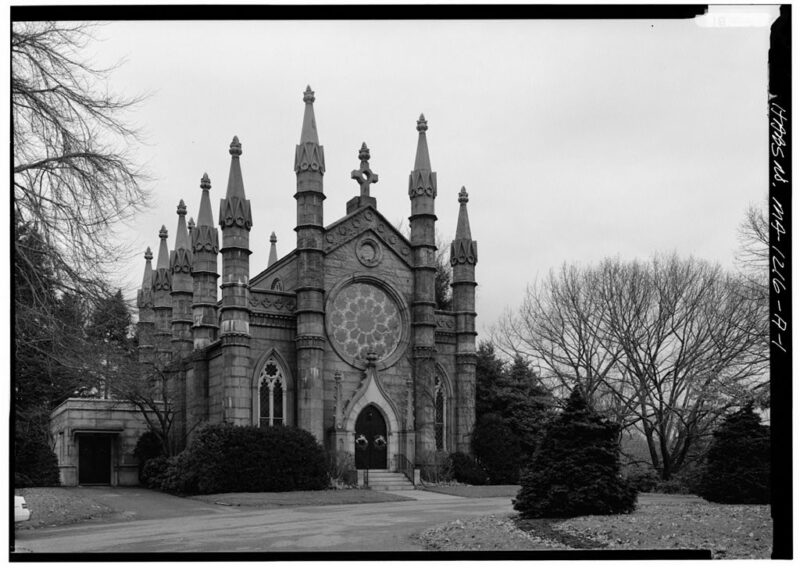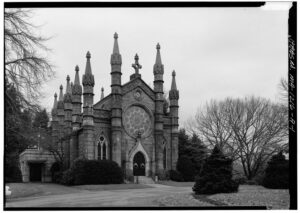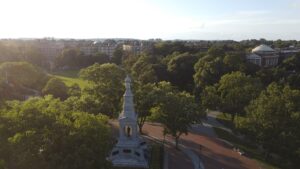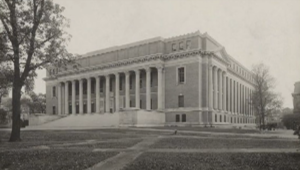Mount Auburn Cemetery, with its inception in the early 19th century, stands today as a significant historical landmark merging natural beauty with monumental tribute. Situated in Cambridge and Watertown, Massachusetts, Mount Auburn is renowned for being America’s first garden cemetery, a concept inspired by the rural cemetery movement and the principles of English landscape design.
Its establishment in 1831 as both a place of burial and a nature preserve broke the traditional norms of graveyards at the time, offering a serene and picturesque environment for remembrance and reflection.
The distinguished resting place harbors the remains of numerous notable figures who have left indelible marks on history. As a National Historic Landmark, Mount Auburn Cemetery is not only a testament to lives past but remains an active institution, dedicated to preservation efforts and educational outreach.
Its evolution over the years both in design and purpose showcases a continual adaptation to the attitudes towards death, commemoration, and conservation.
Key Takeaways
- Mount Auburn Cemetery is America’s first garden cemetery, blending burial spaces with pastoral landscapes.
- The cemetery serves as the final resting place for historical figures, maintaining its relevance and educational significance.
- Ongoing preservation and cultural engagement ensure Mount Auburn remains an integral part of contemporary discourse on heritage and conservation.
Founding and Establishment

Mount Auburn Cemetery is distinguished as the first large-scale, designed landscape open to the public in North America. It was founded in 1831 by members of the Massachusetts Horticultural Society, which included notable figures such as Dr. Jacob Bigelow.
The cemetery’s origins are pivotal in American cemetery design history, marking the transition from conventional small graveyards to the creation of peaceful, garden-like spaces for both the living and the deceased.
The initial acquisition of the land, authorized by the Massachusetts Legislature for use as a garden or rural cemetery, set in motion the establishment of Mount Auburn on what was then a 70-acre tract. The land was purchased for $6,000 and later expanded to encompass 170 acres, accommodating the need for a vast, serene resting place away from the city’s hustle.
The cemetery’s layout was influenced by the principles of English landscape design, rendering it a place of natural beauty with a varied terrain shaped by geological forces. This new type of American landscape was innovative, integrating permanent family lots and operating as a nonprofit corporation.
Key Features at Founding:
- Year Founded: 1831
- Original Size: 70 acres
- Expansion: To 170 acres
- Location: Outside city center
- Operations: Nonprofit corporation
- Design Influence: English landscape
Mount Auburn’s groundbreaking design would become a template for future cemeteries across the United States, signaling the onset of the rural cemetery movement. Its founding principles and design continue to influence the development and transformation of cemeteries even today.
Evolution of Cemetery Design

The design of cemeteries in America has transformed significantly over the centuries, showcasing an array of architectural styles and evolving cultural attitudes toward death and commemoration. Among these transformations, Mount Auburn Cemetery stands as a seminal milestone.
Early American Cemeteries traditionally mirrored European churchyards, being pragmatic and dense with minimal planning. By contrast, inspired by the English landscape movement, Mount Auburn introduced the concept of a ‘rural’ cemetery in 1831. This represented a paradigm shift, intertwining burial grounds with park-like settings. The founders of Mount Auburn envisaged a serene environment where natural beauty exalts the landscape’s solemn purpose.
Key Architectural Styles:
- Classical: Reflecting ancient Greek and Roman influences through columns and mausoleums.
- Gothic: Using pointed arches and elaborate stonework to evoke spiritual reverence.
- Exotic: Incorporating Egyptian and Asian motifs, symbolizing a broader cultural appreciation.
Landmarks within Mount Auburn, such as the Washington Tower and the Bigelow Chapel, epitomize the cemetery’s diverse architectural heritage. These structures not only serve as functional elements but also as art forms, influencing the atmosphere of contemplation and peace.
The Mount Auburn Cemetery’s design evolution reflects broader trends in cemetery development, showing an increasingly individualized and aesthetically focused approach to memorialization. Each advancement not only illustrates the era’s stylistic preferences but also speaks to society’s changing relationship with death and remembrance.
Notable Figures and Memorials

Mount Auburn Cemetery is not just a burial ground but a pantheon of American history, commemorating the lives of luminaries and showcasing artistic memorials that reflect the nation’s cultural heritage.
Artistic Tombs and Monuments
At Mount Auburn Cemetery, one can encounter an array of artistic tombs and monuments that offer a window into historical aesthetics and personal narratives. For instance, the 1856 Marble Sculpture of three small children is both a poignant memorial and a significant art piece, representing the children of Elisha Atkins against a backdrop of Victorian-era mortality rates.
Furthermore, the cemetery’s should also be recognized as a compendium of distinguished landmarks. Within its grounds, the beauty of sculpture intertwines with nature, exemplified by works such as the statue of Hygeia or the Binney Monument, accentuating the cemetery’s reputation as an outdoor museum.
Prominent Individuals Interred
Among the individuals laid to rest here, one finds a roster of notable burials Mount Auburn includes poets, reformers, scientists, and statesmen who’ve left indelible marks on society. To name a few:
- Robert Creeley (1926 – 2005): A modernist poet known for his influence on language and form.
- Dorothea Dix (1802 – 1887): A tireless advocate for the mentally ill and instrumental in hospital reform.
- Mary Baker Eddy (1821 – 1910): The founder of Christian Science, a religious movement emphasizing metaphysical healing.
- Edward Everett (1794 – 1865): An esteemed orator and politician, whose renown is still felt within the historic narratives.
These individuals and their final resting places form a nexus between the living and the legends, with each grave telling the tale of a life of import, the reflections of which still ripple through time. Mount Auburn doesn’t merely offer solace in the face of mortality, but rather, it serves as a testament to human achievement and memory.
Preservation and Conservation
Mount Auburn Cemetery’s commitment to preservation and conservation stands at the forefront of its operations, ensuring that both the natural and historical elements of the cemetery are maintained for future generations. These efforts are meticulously carried out through a series of restoration projects and sustainable horticultural practices.
Cemetery Restoration Projects
Mount Auburn Cemetery has made significant strides in preserving its rich historical heritage. The cemetery has an ongoing commitment to the conservation of its notable monuments and historic structures.
For instance, the conservation of the Binney Monument demonstrates the meticulous care taken to maintain the cemetery’s artistic heritage. Periodic assessments are conducted to ensure that preservation needs are met, reflecting the cemetery’s ever-evolving management plans.
Horticultural Practices
In terms of horticulture, Mount Auburn exemplifies excellence in sustainable landscaping and ecological stewardship. The adoption of the Eternally Green initiative underscores their holistic approach to environmental sustainability and landscape enhancement.
Practices such as the amphibian reintroduction project and the development of wildlife action plans indicate a profound respect for biodiversity. Furthermore, the maintenance teams at Mount Auburn apply preservation plans not only to uphold the aesthetic value but also to support the local ecosystem.
Educational Outreach and Tours
Mount Auburn Cemetery provides a wealth of educational programs and historical tours, focusing on a range of topics from conservation to art. These initiatives are designed to engage the public and provide insights into the cemetery’s rich heritage.
Public Programs
Mount Auburn Cemetery offers a variety of public programs throughout the year, catering to those interested in learning about the site’s historic significance, horticultural practices, and artistic elements. They include lectures, workshops, and special events that celebrate and educate about the cemetery’s unique place in American history and culture.
Guided Historical Tours
Guided historical tours at Mount Auburn showcase the cemetery’s remarkable past and architectural treasures. Visitors can immerse themselves in explorations that typically extend up to 90 minutes, guided by knowledgeable staff members or trained volunteer docents. These engaging tours illuminate stories of the significant figures resting at Mount Auburn and the site’s pivotal role in shaping the concept of American parks.
- Tour Topics: History, art, architecture, conservation, horticulture
- Duration: Approximately 90 minutes
- Guides: Cemetery staff members or volunteer docents
The guided tours for groups cater to educational and non-profit organizations, emphasizing the cemetery’s influence as one of the first large-scale designed landscapes open to the public in North America.
Cemetery Landmarks and Features
Mount Auburn Cemetery garners recognition for its remarkable landmarks and diverse collection of plants. Visitors and historians alike are drawn to both the cemetery’s architectural finesse and its lush landscape.
Architectural Highlights
Mount Auburn Cemetery is celebrated for its various architectural styles that range from Gothic to Egyptian revival. The Washington Tower, a notable structure within the cemetery, offers panoramic views of the surrounding landscape and is an excellent example of Gothic revival architecture.
Its intricate stonework and stately presence illustrate the level of craftsmanship typical of such historical monuments. In addition to the tower, the Bigelow Chapel, characterized by its stunning stained glass and stonework, showcases a mix of styles including Victorian Gothic, symbolizing the cemetery’s rich architectural heritage.
Landscape and Horticulture
The cemetery’s design reflects the principles of 19th-century landscape gardening, a blend of nature and artistry to create serene vistas. It features an impressive collection of flora, with over 5,500 trees encompassing North American and exotic species, some of which are labeled to guide and educate visitors.
The well-maintained paths and ponds are not only key elements in the cemetery’s aesthetic but also contribute to the biodiversity of the habitat.
The Asa Gray Garden stands as a testament to the horticultural significance of Mount Auburn Cemetery, with a selection of plants that provide year-round interest, making the cemetery a living museum of plant life.
Modern Challenges in Preservation
Mount Auburn Cemetery faces several preservation efforts to maintain its historic landscape and monuments. With a legacy of innovation since its establishment in 1831, the cemetery is confronting contemporary challenges to continue its conservation mission.
Environmental Factors: Climate change poses significant threats, causing unpredictable weather patterns that affect the landscape. Increased storms and temperature fluctuations can damage delicate structures and historical plant species that require stable conditions.
Cultivating Expertise: There is a growing need to foster a new generation of skilled conservation professionals. The cemetery requires artisans and horticulturists adept in cemetery conservation, familiar with both traditional techniques and modern technologies.
- Balancing Access and Preservation: Public access to the cemetery is essential for education and inspiration. Yet, frequent visitation can accelerate wear on aging paths and monuments. Crafting policies that protect while providing accessibility remains a delicate endeavor.
- Sustainable Practices: Implementing long-term sustainable practices is crucial. The use of eco-friendly materials and methods is being explored to ensure that conservation work does not adversely impact the environment or the cemetery’s aesthetic.
Financial Resources: Secure, ongoing funding is imperative for large-scale preservation projects. The necessity to apply for grants and engage in fundraising initiatives is ongoing to guarantee that the necessary resources are allocated for conservation works.
Each challenge requires methodical planning and a commitment to the cemetery’s historical integrity, to guarantee that Mount Auburn remains a testament to American landscape design and cemetery practices.
The Cemetery in Contemporary Culture
Mount Auburn Cemetery has embraced its role in contemporary culture by positioning itself not only as a final resting place but also as a site of historical and educational significance. They integrate this through various programs, including historical cemetery tours, which allow visitors to explore the beautifully landscaped grounds and learn about the individuals who have shaped American history.
The cemetery often serves as a living museum, evidenced by its curations and the stewardship of its extensive collections. Visitors can witness the intersection of the past with the present, as Mount Auburn continues to reimagine the cemetery as a museum.
In addition, cultural events and artistic performances are periodically held within the cemetery, providing a serene backdrop that contrasts with the typical venues used for such events. These gatherings are respectful of the site’s primary purpose while highlighting its significance as a cultural institution.
- Public Attractions:
- Historical tours: Guided exploration of the site’s rich heritage.
- Art exhibitions: Displaying works that reflect on the themes of life and death.
- Educational programs: Focused on history, art, and the preservation of wildlife.
Mount Auburn’s historical significance is a point of pride for the community. It was founded in 1831 and marked the first large-scale designed landscape accessible to the public and established outside a city center, a pioneering concept for North American cemeteries. These features are emphasized during tours, solidifying the cemetery’s historical narrative.
Through these contemporary engagements, the cemetery fortifies its relevance. It stands as an educational resource while honoring its legacy, marrying the historic with the modern in a delicate balance that has become part of the cultural fabric of the region.
Frequently Asked Questions
Mount Auburn Cemetery is a place rich in history and diverse in its landscape. These FAQs provide insights into some of the most curious and significant aspects of the cemetery.
Who are some notable individuals buried in Mount Auburn Cemetery?
Mount Auburn Cemetery is the final resting place of many prominent historical figures, including Boston Brahmins and renowned intellectuals, artists, and scientists.
What is the historical significance of the sphinx monument within Mount Auburn Cemetery?
The sphinx monument at Mount Auburn is a memorial to those who died during the Civil War. It symbolizes the struggle for freedom and the sacrifices made.
How large is Mount Auburn Cemetery and how is this space organized?
Spanning over 170 acres, the cemetery is organized into a carefully designed landscape with family lots, and it’s open to the public, serving as a serene space outside the city center.
Can you describe the design and layout of Mount Auburn Cemetery?
The design of Mount Auburn Cemetery integrates a large-scale landscape, strategically blending natural beauty with memorial architecture, reflecting the garden cemetery movement of the 19th century.
What is the story behind the oldest grave at Mount Auburn Cemetery?
Mount Auburn’s oldest graves date back to its founding in 1831, marking the beginning of the garden cemetery concept in North America.
How can visitors locate specific graves or plots within Mount Auburn Cemetery?
Visitors seeking to locate graves or plots are assisted by Mount Auburn Cemetery’s unique archival records, with staff providing support for genealogical and research requests.
Conclusion
Mount Auburn Cemetery stands as a testament to both cultural evolution and landscape design innovation in American history.
As the first rural or garden cemetery in the United States, it represents a pivotal shift away from crowded urban graveyards towards more serene and pastoral resting places. Its significance is emphasized through its designation as a National Historic Landmark.
Esteemed individuals from the Boston Brahmins, a class of New England’s historical elites, as well as other notable figures, find their final resting place amongst its tranquil paths. Mount Auburn’s impact on cemetery design cannot be overstated; it sparked the rural cemetery movement, influenced by English landscape aesthetics, deeply shaping the American approach to commemorating the deceased.
The cemetery’s adoption of the garden aesthetic demonstrates an early appreciation for natural beauty and careful planning. It serves as both a heritage site and an arboretum, with the Massachusetts Horticultural Society’s influence evident in the variety of plant life that adorns the grounds.
In summary, Mount Auburn Cemetery’s narrative intertwines the cultural attitudes towards death, the evolution of societal norms, and a flourishing respect for the landscape. It persists as a space where history, art, and nature converge, offering insight into the values and visions of 19th-century America and its ongoing legacy.
Related Posts:
- Cambridge Common Through the Ages - Historical Landmark
- Inside the Houghton Library: A Treasure Trove of…
- A Closer Look at History of MIT - The Legacy and Innovations
- Cambridge Science Festival 2023 Highlights - What…
- Best 14 Things To Do And See In Cambridge…
- Top 13 Restaurants in Cambridge, Massachusetts in…

















